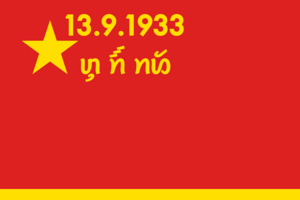Red Liberation Army (RLA)
| Red Liberation Army (RLA) | |
|---|---|
 | |
| Service branches | |
| Leadership | |
| Commander-in-Chief | Generalissimo Gadzi |
| Personnel | |
| Military age | 18 |
| Conscription | Yes (male & female) |
| Available for military service | 11,400,000 (est.), age 18-45 |
| Fit for military service | 10,600,000 (est.), age 18-45 |
| Active personnel | 361,000 |
| Reserve personnel | 5,337,500 |
| Deployed personnel | None |
| Expenditure | |
| Budget | $13,702,119,000 |
| Percent of GDP | 3.04% |
| Industry | |
| Domestic suppliers | Posadi Defense Industries Kharoi Missile Factory |
The Red Liberation Army acts as the official military of Posadastan.
History
Conscription
The practice of conscription began in 1890 to build up a stronger, more capable military. It carried on until the fall of the Monarchy in 1929 and the fall of the Republic in 1933. Under the early communist government it was written in law but was not enforced until 1940 after the death of Chairman Lenin. The Federation of Communes banned conscription in 1942 after its ascension to power, but it was brought back by the Posadists in 1975.
Since 1975, all Amonian males were required to do 2 years of military service starting at the age of 18. Between 1988 and 1994, Generalissimo Hao began integrating indigenous groups into the draft, and in 2010 Amonian women were included. Women were only required to do 18 months, but could opt (alongside select males, typically those deemed “unfit for service”) to take part in numerous 2 year “national service” programs.
National Service programs include working in schools, special education, administration, hospitals, law, geriatrics, nursing homes, health clinics, teens at risk, internal security (policing, PRG membership, ISB training, etc.), disadvantaged communities, conservation bureau, immigrant assistance, youth organizations, and others.
After completing the conscription period, all former conscripts are automatically enrolled for reserve duty until the age of 45 (for males) or 40 (for females). That is, unless they become exempted during that period.
There are also various forms of deferment: - Volunteering for a 1-year service in a youth organization. - Graduating high school - Postponement due to extenuating personal circumstances
It is also possible for some conscripts to complete higher education while carrying out their military service. It is called the “Essential Academic Program,” or in Posadi, “ꪕꪲꪇꪴ ꪅꪳꪱꪸꪆꪴ ꪕꪲꪏꪭꪰ.” This program is reserved for conscripts who have “exhibited outstanding academic performance” and “leadership potential” in fields that are applicable to “advancing the future of Posadastan.” Such programs include all STEM majors (insofar as it applies to military research and development, or essential economic activity), and select courses run by the ISB on psychology, technology, and security services (only for select individuals), or advanced medical research and education like surgeons and doctors.
There is also an academic reserve (“ꪅꪤꪸꪆꪴ ꪇꪴꪹꪠ”) for those individuals who want to pursue higher education in fields not applicable to the above “prior to military service. If allowed, they may be allotted 1 to 4 years to pursue a degree in whatever field they desire before being drafted. This does of course come with academic stipulations such as maintaining a minimum GPA of 2.5 and holding an approved job throughout the allotted period. This academic reserve is mostly for those pursuing nursing, economics, law, and other “non-immediately essential degrees,” but some flexibility is applied.